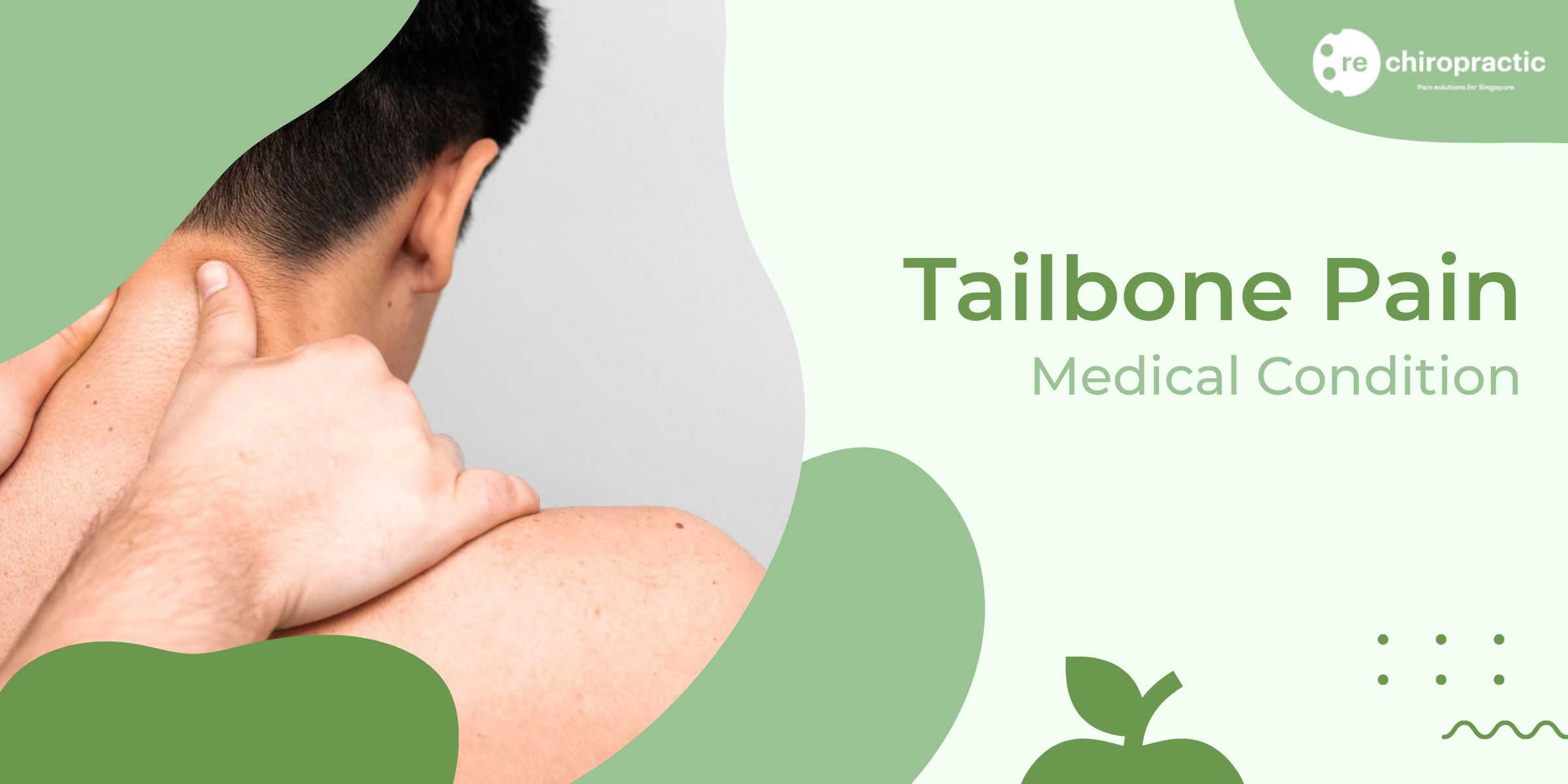
Tailbone Pain
Tailbone pain, also known as coccydynia, is a common condition that affects the tailbone or coccyx, which is the small triangular bone at the bottom of the spine. This condition can cause discomfort and pain in the lower back and buttocks area, making it difficult for individuals to sit or engage in activities that put pressure on the tailbone.
Symptoms & Different Stages of Tailbone Pain
Tailbone pain, also known as coccydynia, can vary in intensity and duration depending on the individual. The symptoms experienced can range from mild discomfort to severe pain, making it important to understand the different stages of this condition.
- Stage 1: In the initial stage, individuals may experience mild discomfort or a dull ache in the tailbone area. The pain may worsen when sitting for long periods or when pressure is applied to the area.
- Stage 2: As the condition progresses, the pain becomes more intense and may radiate to the lower back or buttocks. Sitting and certain movements, such as standing up from a seated position or bending forward, can exacerbate the pain.
- Stage 3: At this stage, the pain becomes severe and chronic. It can significantly impact daily activities and quality of life. Simple tasks like sitting or even lying down can become excruciatingly painful.
It is important to note that the severity and progression of tailbone pain can vary from person to person. Some individuals may experience a rapid progression through the stages, while others may remain in a particular stage for an extended period.
Identifying when tailbone pain requires medical attention is crucial. If you experience any of the following symptoms, it is advisable to seek professional help:
- Severe and persistent pain that does not improve with self-care measures
- Pain that worsens over time or interferes with daily activities
- Numbness or tingling sensation in the legs or buttocks
- Difficulty controlling bowel movements or bladder function
- Unexplained weight loss
These symptoms may indicate underlying conditions or complications that require further evaluation and treatment by a healthcare professional.
Most Common Causes of Tailbone Pain
There are several factors that can contribute to the development of tailbone pain, also known as coccydynia. Understanding the typical causes of this condition can help individuals identify potential triggers and seek appropriate treatment. Here are the most common causes of tailbone pain:
- Trauma: Injury to the tailbone, such as falling directly on the buttocks or experiencing a blow to the area, is a common cause of coccydynia. This can result in bruising, inflammation, or even fractures.
- Childbirth: Women who have recently given birth may experience tailbone pain due to the pressure and trauma exerted on the coccyx during delivery. The position of the baby’s head and the stretching of the pelvic floor muscles can contribute to discomfort in this area.
- Prolonged sitting: Sitting for extended periods, especially on hard surfaces, can put excessive pressure on the tailbone and surrounding tissues. This can lead to inflammation and pain over time.
- Repetitive activities: Engaging in activities that involve repetitive movements, such as cycling or rowing, can strain the muscles and ligaments surrounding the tailbone. Overuse and improper form can contribute to the development of coccydynia.
- Obesity: Carrying excess weight puts additional stress on the tailbone and can exacerbate existing pain or lead to its development.
- Infection: Although rare, infections in the area surrounding the tailbone can cause inflammation and discomfort. Conditions such as pilonidal cysts or abscesses can lead to coccydynia.
It is important to note that tailbone pain can have multiple causes, and in some cases, the exact trigger may be difficult to determine. Consulting with a chiropractor can help identify the underlying cause and develop an appropriate treatment plan.
How bad can tailbone pain get if left untreated?
- Increased pain intensity: If left untreated, tailbone pain can worsen over time. The pain may become more intense and persistent, making it difficult to sit, stand, or perform daily activities.
- Chronic pain: Ignoring tailbone pain can lead to the development of chronic pain. The constant discomfort can significantly impact a person’s quality of life, making it challenging to engage in physical activities or even sit comfortably for extended periods.
- Restricted mobility: As tailbone pain progresses, it can limit a person’s ability to move freely. The pain may radiate to the surrounding areas, making it uncomfortable to walk or engage in physical activities that involve the lower back and hips.
- Emotional distress: Chronic pain can take a toll on a person’s mental well-being. The constant discomfort and limitations imposed by tailbone pain can lead to frustration, irritability, and even depression or anxiety.
- Impaired work and daily life: If left untreated, tailbone pain can interfere with work productivity and daily life. Sitting for prolonged periods may become unbearable, affecting job performance and overall functionality.
- Complications: In rare cases, untreated tailbone pain can lead to complications such as infections or abscesses. These complications may require more invasive treatments or surgeries to resolve.
Chiropractic for Tailbone Pain
Chiropractic care offers a holistic approach to treating tailbone pain, focusing on the alignment and function of the spine and surrounding structures. Through various techniques and interventions, chiropractors aim to alleviate pain, improve mobility, and enhance overall well-being for individuals suffering from this condition.
Here are some ways in which chiropractic care can help with tailbone pain:
- Spinal adjustments: Chiropractors use manual manipulation techniques to realign the spine and pelvis, reducing pressure on the tailbone and relieving pain.
- Soft tissue therapy: By applying targeted pressure and stretching techniques, chiropractors can release tension in the muscles and tissues surrounding the tailbone, promoting healing and reducing discomfort.
- Posture correction: Poor posture can contribute to tailbone pain. Chiropractors assess and correct posture imbalances to alleviate stress on the tailbone and improve overall spinal alignment.
- Exercise prescription: Chiropractors may recommend specific exercises to strengthen the muscles supporting the tailbone, enhancing stability and reducing the risk of further injury.
- Ergonomic advice: Chiropractors provide guidance on proper body mechanics and ergonomics to minimize strain on the tailbone during daily activities and prevent future pain episodes.
Chiropractic care offers a non-invasive and drug-free approach to managing tailbone pain. By addressing the underlying causes of the condition, chiropractors aim to provide long-term relief and improve the overall quality of life for individuals suffering from this discomfort.
Self Help & Relief for Tailbone Pain
Dealing with tailbone pain can be quite distressing, but there are several self-help methods that can provide relief and improve your condition. Here are some safe and effective techniques you can explore:
- Apply ice or heat: Applying ice packs or heating pads to the affected area can help reduce inflammation and alleviate pain. You can try alternating between cold and hot treatments to see which one works best for you.
- Practice good posture: Maintaining proper posture can significantly reduce pressure on your tailbone. When sitting, make sure to sit upright with your feet flat on the floor and your weight evenly distributed. Avoid slouching or sitting for extended periods without breaks.
- Use a cushion: Sitting on a cushion or a specially designed donut-shaped pillow can help relieve pressure on the tailbone. These cushions redistribute weight and provide support, allowing for more comfortable sitting.
- Avoid prolonged sitting: If your work or lifestyle involves long periods of sitting, try to take frequent breaks and incorporate gentle stretching exercises. Standing and walking breaks can help prevent the aggravation of tailbone pain.
- Engage in gentle exercises: Low-impact exercises, such as swimming or walking, can help strengthen the muscles surrounding the tailbone and improve overall flexibility. However, it is important to avoid activities that put excessive strain on the area.
- Practice relaxation techniques: Stress and tension can exacerbate tailbone pain. Engaging in relaxation techniques, such as deep breathing exercises, meditation, or yoga, can help reduce stress levels and promote healing.
- Avoid activities that worsen the pain: Identify activities or positions that worsen your tailbone pain and try to avoid them. This may include activities that involve prolonged sitting on hard surfaces, heavy lifting, or repetitive movements that strain the area.
While these self-help methods can provide temporary relief, it is essential to consult with a chiropractic health professional for a comprehensive evaluation and personalized treatment plan. They can address the underlying causes of your tailbone pain and provide targeted chiropractic adjustments and therapies to promote long-term healing and pain management.
When to Seek Medical Help for Tailbone Pain
If you are experiencing persistent tailbone pain, it is important to seek medical help. Living with pain is not something you should endure, as it can greatly impact your quality of life. While there are self-relief methods that can provide temporary relief, it is crucial to address the underlying cause of your tailbone pain.
When the pain becomes severe and interferes with your daily activities, it is time to consult a healthcare professional. They can evaluate your condition, perform necessary tests, and provide a proper diagnosis. Seeking medical help is especially important if you have experienced a traumatic injury to your tailbone, such as a fall or direct impact.
Additionally, if your tailbone pain is accompanied by other concerning symptoms, it is crucial to seek immediate medical attention. These symptoms may include:
- Persistent numbness or tingling in the legs or buttocks
- Difficulty controlling bowel movements or bladder function
- Unexplained weight loss
- Fever
- Severe pain that worsens over time
Remember, tailbone pain should not be ignored or dismissed. Seeking medical help will allow for a comprehensive evaluation and appropriate treatment plan. A healthcare professional, such as a chiropractor, can provide targeted therapies to alleviate your pain and improve your overall well-being.
Don’t let tailbone pain hold you back from enjoying life to the fullest. Reach out to a medical professional and take the first step towards finding relief and restoring your comfort.

Dr. Jenny Li is America trained chiropractor who specialises in sports injury, sports performance, and spinal health. She graduated from Palmer College of Chiropractic in United States, upon completion of the her post graduate program she practiced in Hong Kong and currently is practicing in Singapore.

